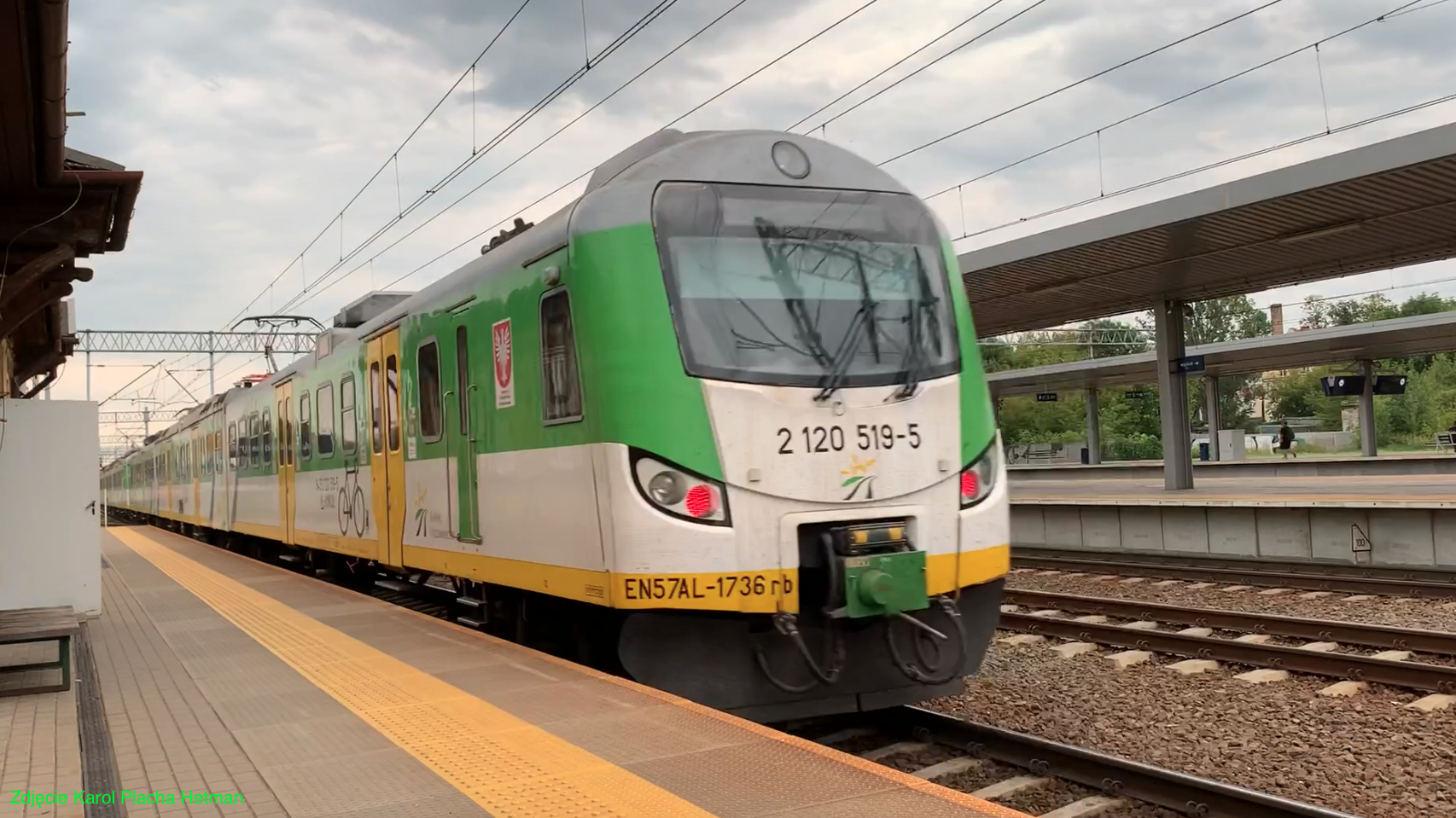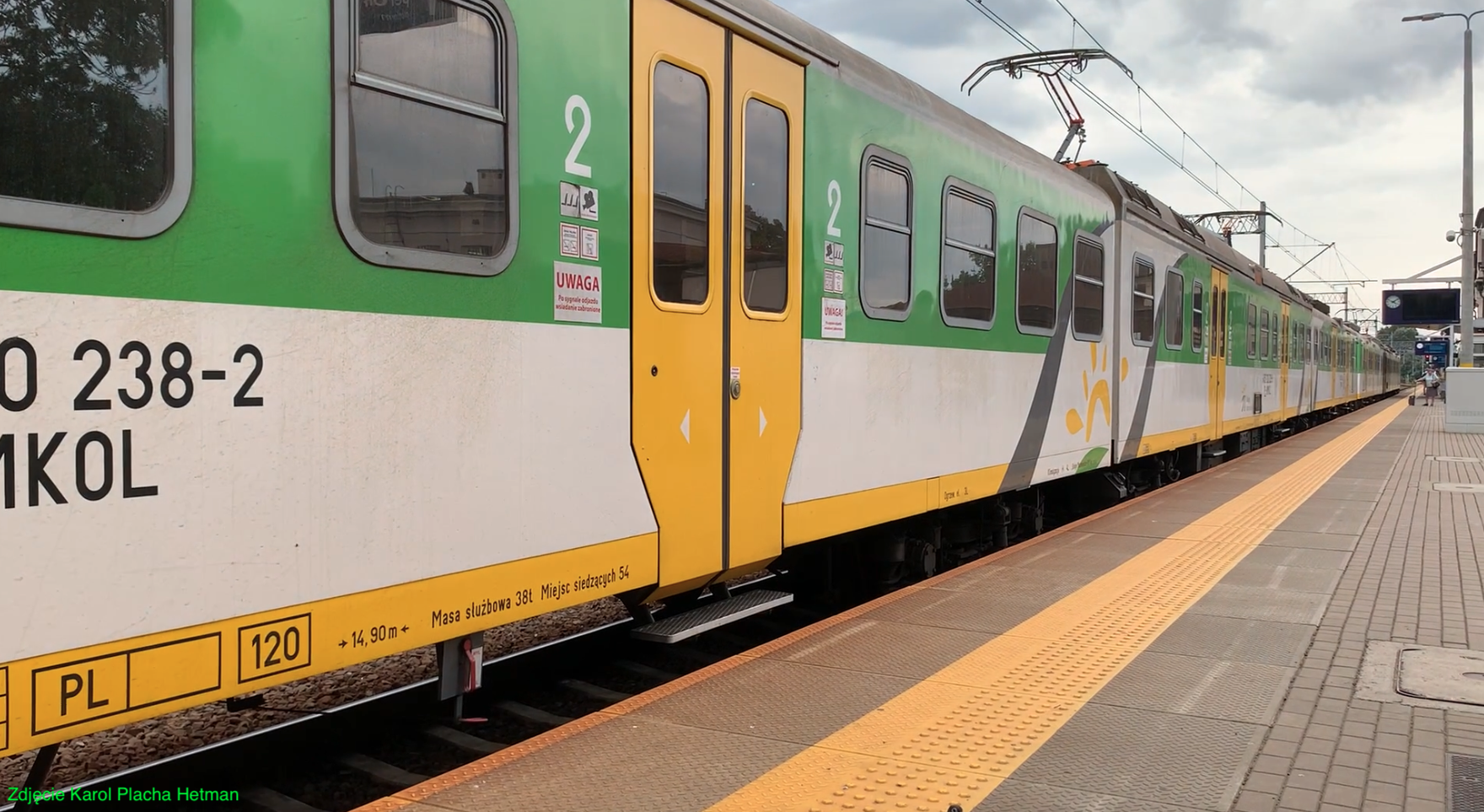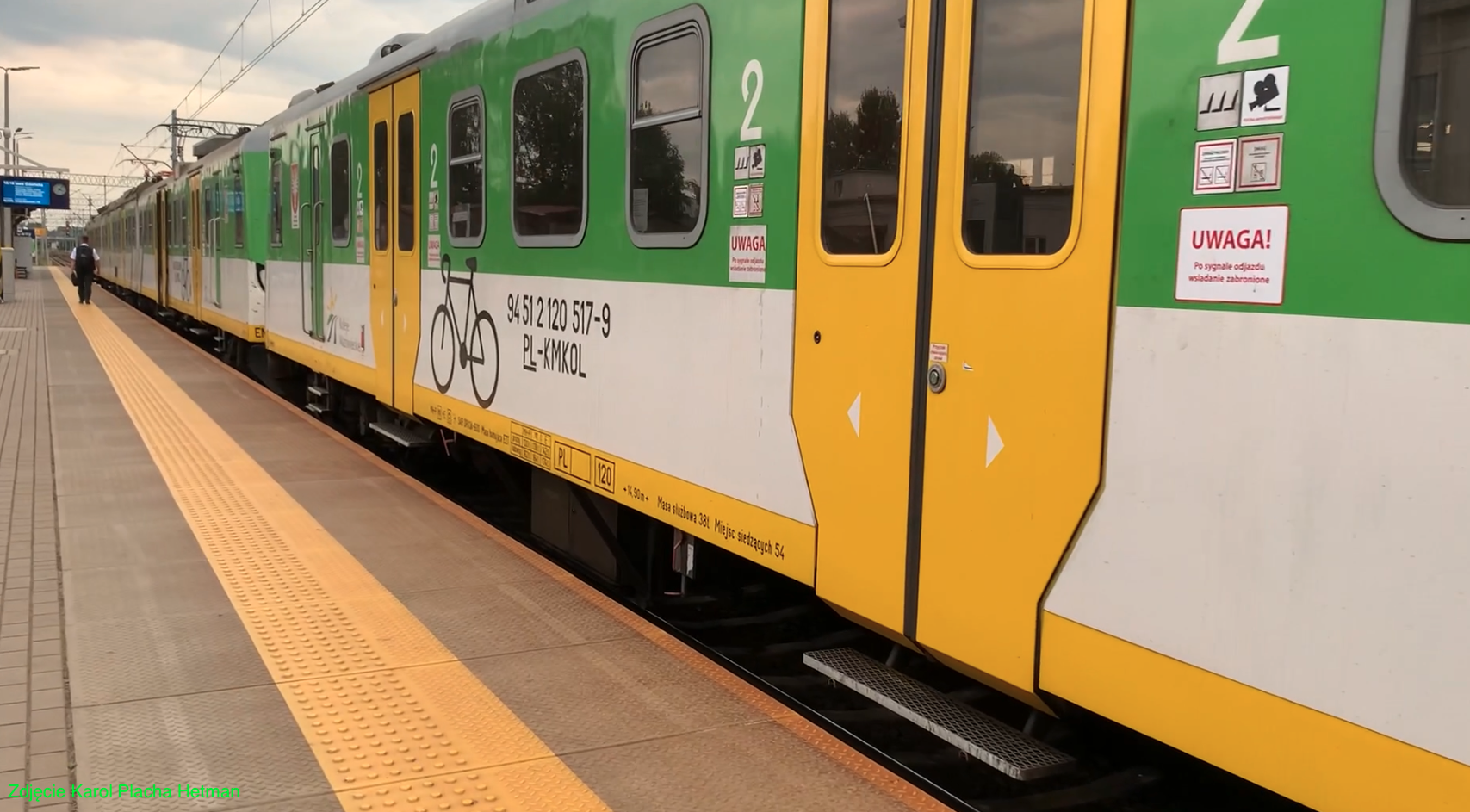Mińsk Mazowiecki 2023-09-06
EZT Mińsk Mazowiecki EN57AL.
The EN57 Electric Multiple Unit is a legend on Polish tracks.
In the 1950s, electrification of the main railway junctions was already planned and implemented. People were already thinking about electric suburban passenger trains at that time. Additionally, there was a problem that the main stations had high platforms (40 - 50 cm from the rail head). Subordinate stations, however, had low platforms, sometimes as high as the curb. Therefore, future passenger trains should serve all platforms.
Design work on the new passenger train was carried out in the period 1959–1961, in parallel with the EW55 EMU train for the Warsaw and Gdańsk junctions. Therefore, the compositions of EN57 and EW55 are very similar. They differ in the number of door pairs in one carriage and the entrance steps. The documentation was prepared by the Central Design Office of the Rolling Stock Industry Poznań (currently OBRPS Poznań). The prototype EN57 train made its first run in December 1961. Production was located in Wrocław at the "PaFaWag" factory. In the "PaFaWag" factory, power wagons were marked type 6B, and control and control wagons were type 5B.
The EN57 EMU is a Polish design that was produced from January 1962 to July 1993, i.e. for 31 years. The EN57 train is the longest-produced rail vehicle in the world. In 2021, the 60th anniversary of the first train, an electric unit, was built. A total of 1,429 units were built. Other sources give the number of 1,452 units, including those exported to Yugoslavia and four-car units.
Based on the EMU EN57 composition, the "PaFaWag" factory also built four-unit units with an additional motor unit, which were marked EMU EN71. The first such train was built in 1964. These trains were initially created to service the difficult Krakow - Zakopane route. In 1965, Yugoslavia bought this type of trains. Apparently, in Yugoslavia, trains were called "Gomułka" after Władysław Gomułka (first secretary of the Polish United Workers' Party), during whose times the trains were sent to the Balkans.
Generally speaking, it can be said that there were three production series of EN57:
Serial numbers 001 - 130 and 601 - 1 113, which had grooved sides and three windows in the front wall. Ribbed sheets increase the stiffness of the structure, just like stringers in aircraft fuselage structures. Additionally, some trains had a first-class compartment.
Serial numbers 1,114 - 1,825 have smooth sides of the boxes and three glass panes in the front wall.
Serial numbers 1,900 - 1,953 have smooth sides and two windows in the front wall, similar to EW58. Additionally, the driver's cab is equipped differently because the installed systems are slightly different.
Serial numbers 2001 - 2075 were assigned to the trains after modernization according to the SPOT program, i.e. Sectoral Operational Program Transport.
Serial numbers 3001 - 3010 were assigned to trains that returned from the countries of the former Yugoslavia and were renovated and retrofitted.
Operation of EMU trains EN57.
In the 1980s, central door opening by the driver, not the train manager, was introduced in ETZ EN57 trains. Additionally, an acoustic warning signal for door closing has been introduced.
In 1993, during the modernization, trains were also built with a separate Class 1, in the Rb wagon. They had upholstered airline seats, curtains on the windows and a sound system. There was also a so-called bar compartment with a stove, sink and refrigerator.
Long years of operation of EN57 EMU trains resulted in users subjecting them to various modifications. As standard, since 1989, trains have been repainted. Traditional yellow and blue painting was characteristic of the Polish People's Republic period. That's why the trains were called "yellows". New carriers paint trains in their own colors. Currently (2023), the most famous painting in Poland is the painting of the PolRegio carrier.
For the last 90 years, modernization has included, among other things, adapting vehicles for disabled people. The IT system was modified and a sound system was introduced. The heating was improved. Air conditioning was installed in the driver's cabins and passenger compartments. The windows were replaced with double-glazed ones. Compartments for transporting bicycles were introduced.
A big change was the replacement of traction motors with asynchronous motors, which are controlled by an inverter. These engines are more powerful, because each engine has a power of 250 kW. A train with such engines reaches a speed of up to 125 km/h, compared to 90 km/h with previous 125 kW engines.
Interestingly. Many components from scrapped trains are used in the new rolling stock. This is the case, for example, with powered bogies. Also stands and box frames are used. Sometimes trains built on such a basis still have the EN57 marking, but very high serial numbers. In turn, others receive a completely new marking, and their appearance does not reveal their origin from EN57. This was the case, for example, with the Newag 14WE trains, 9 of which were built between 2005 and 2009. As part of the SPOT program (Sectoral Operational Program Transport) in 2006 - 2007, 75 EN57 EMU trains were modernized and given serial numbers 2001 - 2075.
The modernized trains are equipped with an anti-theft system with motion detectors and 16 cameras, the preview of which is visible on the screen in the driver's cabin, which continuously monitors the interior of the vehicle and records on memory cards.
In 2007, several trains for SKM Trójmiasto and Koleje Mazowieckie were modernized to the EN57 KM version, where the electrical systems were significantly improved, including the replacement of resistance starting with impulse starting. In 2008, Koleje Mazowieckie ordered the modernization of 10 trains to the EN57 AKM version. The trains were equipped with LK450X6 alternating current (asynchronous) motors, developed by EMIT from Żychlin. The new engine has a power of 250 kW, and the entire train has a power of 1 MW, which significantly improved the traction parameters of the vehicles. Acceleration has increased and the maximum speed has been raised to 125 km/h.
Other local governments, such as those in the Łódź Voivodeship or Greater Poland Voivodeship, have also decided to modernize their EN57 EMU trains. The modernization was carried out individually for each entity. Therefore, the trains received very different additional letter markings. Mainly, the motors were replaced with asynchronous ones. New passenger seats and wall coverings were installed. Closed system toilets and toilets for disabled people were installed. The driver's cabins were replaced, new train heads and air conditioning were installed. The external doors were replaced with spring-sliding ones, which are tighter. Ticket machines and vending machines for drinks and sweets were installed.
In September 2017, the PolRegio carrier received the first deeply modernized EN57-2205 train. The train is no longer similar to the classic EN57, although it is marked EN57ALc. A total of 36 units were rebuilt. These trains have already undergone their second P5 level renovation. The renovation was carried out at the ZNTK plant in Mińsk Mazowiecki, which belongs to the PESA group. In the modernized trains, the interior layout is single-space along the entire length and equipped with air conditioning. The seats are aviation-style, well upholstered and very comfortable. There is also Wi-Fi for passengers and 230 V sockets. Each train has two closed system toilets, one of them intended for disabled people and with a changing table for babies. There are also electric hand dryers in the toilets.
Construction of an EN57 EMU unit.
The EN57 train consists of three carriages. The leading wagons are steered and equipped with driver's cabins. They are marked "ra" and "rb" (distributive). These wagons have two bogies. The middle wagon is the power wagon and is marked "s". It has two drive bogies (four engines) and two pantographs (current collectors). Initially with a single slide, and later with a double slide. The pantograph is of the scissor type. Each carriage has two pairs of passenger doors. The rolling wheels have a diameter of 0.94 m. The driving wheels have a diameter of 1.00 m.
The wagons are connected to each other by the so-called "factory" short coupling, which is only disconnected in workshop conditions. Automatic Scharfenberg couplers are installed on the heads of the train, which enable multiple traction.
The wagon base and boxes are made of steel profiles connected by welding. The walls are covered with 2 mm thick sheet metal and the roof with 1.5 mm thick sheet metal. The insulation and extension of the wagon are made of mineral wool. The car floor is at a height of 1.153 m from the rail head. The entrance to the carriage has two steps.
For various reasons, EN57 EMU trains can be found consisting of wagons that come from different EMUs.
The interior of EMU EN57 wagons.
In the 1960s and 1970s, the carriages had soft seats upholstered with leather (green, brown or blue) and were of medium thickness. Unfortunately, due to vandalism, new or renovated trains received hard plastic (composite) sofas in red.
The walls and ceilings in the carriages are lined with a wood-like laminate (light pine). Electric lamps are installed in the ceilings. The windows are divided into halves and the upper part is lowered. The windows have single glazing. All windows are made of tempered glass. Aluminum luggage racks are placed above the windows. The floor is wooden covered with plastic. The carriage's automatic outer doors, operated by compressed air, are 1.30 m wide and lead to a corridor with manually closed inner doors and lead to spacious compartments with a maximum of 32 seats or a standard capacity of up to 24 seats. Passengers move in the middle of the compartments. There are passages between the carriages for passengers and the conductor team with manually closed doors. There are open toilets on the train, which can only be used while the train is running. The toilet has a toilet (seat) and a washbasin. Usually only with cold water. The heaters are electric and placed under the passenger seats. In other rooms, radiators were placed vertically against the walls and covered with sheet metal with holes. The control carriages have compartments for travelers with larger luggage or with bicycles and skis.
There is a separate door in the control car only for train staff. In the driver's cab, the right position was occupied by the driver (mechanic), and the left position by the train manager, who operated the automatic doors centrally.
EMU EN57AL.
The arrangement in the EN57AL wagon is not much different from the wagons in the EN57 trains.




In each carriage there are three compartments for passengers with a central aisle between the seats, separated by two vestibules. The two extreme compartments of the marshalling car are equipped with reclining seats and a rack for five bicycles and are adapted to transport disabled people and bicycles.
The marshalling car also has a toilet adapted for use by disabled people. The toilet is a closed system, a vacuum system from SEMCO. The EMU uses an asynchronous traction drive and an electro-pneumatic braking system. EN57AL series EMUs are designed to operate in multiple traction and are connected using multiple coupling connectors. The front ends of the train are modernized and made of polyester-glass laminate. The train is air-conditioned. The doors are of the spring-sliding type. The door clearance when opened is 1.20 m. The door can be opened with a button or centrally by the driver. The entrance doors have a locking system that prevents them from opening while driving. Passengers have at their disposal an audio-visual passenger information system. The heating and air conditioning system is air-fed.
The drive consists of asynchronous LK 450 X6 motors. The compressor unit is powered by 3 x 400V AC with a maximum capacity of 60 m3/h. Alkaline nickel-cadmium batteries, rated at 100Ah. The driver has a monitoring system at his disposal.
The floors in the wagon bodies are made of corrugated sheet metal, not wood as before. The height of the bends is 25 mm and they are arranged along the wagon. Sound-absorbing and insulating mass and geotextile are placed on the sheet. The whole thing is covered with waterproof plywood, 18 mm thick. At the very top there is a Traveler type anti-slip carpet. The walls and ceiling of the carriage are finished with a polyester-glass laminate. There are four loudspeakers and LCD screens mounted on the ceiling in each carriage. The monitoring system consists of 9 hidden cameras observing all compartments and corridors, and 2 external cameras from each cabin observing the sides of the unit. The image from the cameras is sent to a digital recorder, where it is saved. The image from the cameras is displayed on two monitors, one in each cabin. Internal lighting is provided by 18W and 36W lamps with a bulb placed in each socket as emergency lighting.
Passengers use double, single and reclining seats. There are 171 seats on the train. Luggage shelves are located above the windows, along the side walls and are made of welded and screwed steel profiles. There are numerous handles and handrails in the carriages. Small tables were placed under the windows. Dumpsters were also installed. The bicycle stand is made of a welded structure made of steel profiles, enabling the transport of bicycles in a vertical position.
The carriages have windows with standard dimensions of width 0.75 m and 1.10 m. The windows have double glazing and sun blinds. The upper part of the window can be tilted to an angle of 30 degrees. Additionally, there are two security windows in each compartment.
The driver's cabins are separate rooms secured with doors to prevent unauthorized persons from entering. The cabins can be entered from inside the train and from the outside through separate doors. The train is equipped with cruise control. The braking system is additionally equipped with MED electrodynamic brakes with energy recuperation.
Some trains, such as EN57AL-1938, were equipped with more powerful engines with a power of 350 kW, for a total of 1,400 kW.
Koleje Mazowieckie.
Koleje Mazowieckie was established in 2005.
In the fall of 2022, Koleje Mazowieckie announced that 66 EN57AL trains would be sent for P4 level repairs. Koleje Mazowieckie intends to allocate an average amount of PLN 42,000 net for one vehicle. The carrier expects the repair of each vehicle to be completed within no longer than 55 calendar days. All repairs must be completed by the end of 2025. On February 23, 2023, Koleje Mazowieckie signed an agreement with PESA Mińsk Mazowiecki to perform repairs at the P4 maintenance level for 66 units of the EN57AL series EMUs. The contract value is PLN 130 million gross.
Previous modernizations of the trains were carried out in the period 2005-2013. It was a modernization to the AKM standard. However, in 2014, modernization of trains to EN57AL standards began. The first contract covered 27 trains and was performed in 2014-2015. The modernization of 27 EMU trains was co-financed by the European Union from the Cohesion Fund under the Infrastructure and Environment Operational Program. The next contract covered 39 trains and was performed in 2016-2017. These trains have 160 seats, individual seats. The last modified train was marked EN57AL-1902 and was handed over to Koleje Mazowieckie on May 22, 2017.
In 2020, Koleje Mazowieckie had 66 EN57AL trains. 43 vehicles are stationed at the Rolling Stock Repair and Operation Section in Tłuszcz and serve the R6 Warszawa Wileńska - Małkinia line. 23 copies are in stock of the Rolling Stock Repair and Operation Section in Warsaw Ochota and can be found on the lines to Skierniewice, Siedlce, Łowicz and Dęblin. In total, the vehicles in Koleje Mazowieckie are: EN57 - 47 units, EN57AKM - 71 units, EN57AL - 66 units. Koleje Mazowieckie also has new FLIRT EMUs, numbering 23 vehicles.
Written by Karol Placha Hetman
